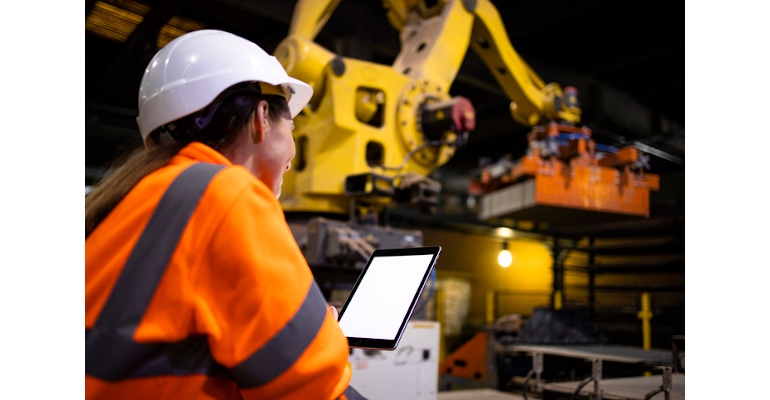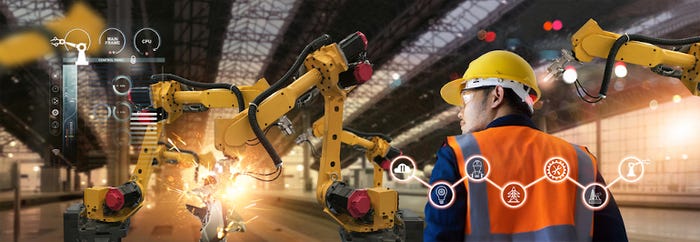Addressing Occupational Health Risks in the Automated Workplace
Can engineers design machines and production lines to minimize automation hazards and avoid injuries?

Automation has changed the way many of our favorite products are manufactured. Cars are a great example. When Henry Ford first brought the Model T to the market, dozens of workers ensured that production lines were working effectively.
Today, car manufacturers rely on robotics and automation to assemble cars and countless other products. No doubt, automation has made manufacturing more productive and efficient. However, passing tasks from human workers to machines has also created additional occupational health risks for professionals. In this article, we take a look at these risks and identify ways engineers can address and mitigate them.
The Impact of Automated Workplaces on Occupational Health
Over the past 30 years, the manufacturing industry in the United States has gone through its most dramatic transformation since the industrial revolution. In most production settings, repetitive and labor-intensive tasks have been taken over by robots and other machines.
According to Industrial Safety & Hygiene News (ISHN), most industry representatives agree that automation has increased safety in general. At the same time, the sector’s growing reliance on technology has also led to complacency that may create new hazards for workers within automated environments. Industry experts may be able to predict some of these hazards, but there are likely others that will remain undiscovered until an incident happens.
Common Health Risks Faced by Workers in the Automated Workplace
Optimizing automated workplaces for safety and efficiency begins by recognizing the strengths and weaknesses of humans and machines, respectively. Automated workflows tend to deliver more consistent and predictable outputs at a set capacity. Humans tend to be not only less consistent, but they also may not have the same output capacity as robotics do.
So, does that mean humans are inferior to machines in workplaces? The answer is no. Human workers beat machines, including robots, when it comes to using judgment and making informed decisions based on experience. Humans use those qualities to adjust what they do, which is something that machines can’t. To create the safest and most-efficient work environment, engineers designing machines and production lines need to reconcile the qualities of both. Some of the most common health risks in automated workplaces that need to be addressed include:
Injuries and illnesses caused by a lack of familiarity with the technology utilized by the company
Injuries and illnesses caused by increasing worker complacency and a lack of monitoring of automated devices
Problems arising from lacking regulation as safety standards lag behind technological developments
Problems arising from non-intuitive or user-unfriendly designs of human-machine interfaces
The Occupational Safety and Health Administration (OSHA) recognized those risks several decades ago as automation was starting to gather momentum. To address the new issues, OSHA published its Directive on Robotics Safety. Aside from addressing practical ways of increasing safety in automated workplaces, the directive also considers why worker behavior changes in these environments. Incident and accident reports have stated that workers can fall victim to an unjustified belief that the system is performing correctly and therefore monitor less or insufficiently.
Worker injuries and even deaths have also occurred when there were gaps in machine guards that put workers at risk. As automation is growing both more common and more sophisticated, these problems are becoming less frequent, although they have not yet been eliminated. One worker at a German Volkswagen plant died as recently as 2015.
Organizations like OSHA and other industry bodies are working hard to keep workers safe in automated environments. However, as technological developments are happening ever faster, there are bound to be gaps in safety regulations as these are being updated to reflect changing circumstances.
Suboptimal interface design can inadvertently predispose workers to safety issues that had not previously been considered. When that happens, problems should not be attributed to human error. Instead, they are wider systemic failures that need to be addressed on a higher level.
Considering occupational health risks from the beginning of the design stage allows engineers to create machines and entire production lines that are built on safety as a principle. Simplifying user interfaces could be part of that. Preventing machines from working when their safeguards have been compromised is another option.
Strategies to Prevent Occupational Health Risks in the Automated Workplace
How can engineers help keep workers safe in automated environments? Above, we have hinted at the importance of addressing systemic failures. Before taking a closer look at those, it’s worth talking about practical precautions.
Not all injuries or illnesses in automated workplaces are dramatic or life-threatening. While those more serious issues tend to attract more publicity, it is equally important to prevent seemingly less-grave injuries. In 2021 alone, employers reported more than 2.5 million workplace injuries and illnesses to the Bureau of Labor Statistics (BLS).

Preventing and dealing with those injuries on the spot often requires not much more than basic first-aid training and quick access to a first-aid kit. The latter is required by law, but rather than considering them an afterthought, it is worth investing time and resources into a first aid kit that is not only well-stocked but also adapted to the environment it is used in.
Similar considerations apply to first aid training. Generally, basic first aid courses can be completed in one or two days, but first aiders must regularly practice their skills and keep their training up to date. Like other motor skills, the ability to perform effective chest compressions, for example, is easily lost when it is not practiced.
To address more systemic issues, the National Institute of Occupational Safety and Health (NIOSH) developed a hierarchy of controls that is part of OSHA’s regulations. The system addresses hazards in different ways. Starting with eliminating the hazard entirely, which is considered the most-effective approach, the hierarchy moves toward less-effective approaches, including:
Substituting hazards
Putting in place engineering controls to isolate humans from the hazard
Administrative controls that change the way individuals work
Issuing workers with personal protective equipment (PPE)
Designing production lines in a way that removes hazards allows engineers to make workplaces safer for their teams. This could be achieved by removing opportunities to override safeguards, limiting the potential of workers putting themselves and their colleagues in danger. Engineers have the power to increase occupational safety starting right at the top of OSHA’s hierarchy.
Not every strategy will work in every scenario, but, when combined, they offer powerful protections for workers.
The Future of Occupational Health in Automated Workplaces: Opportunities and Challenges
Automation is here to stay, and more tasks will be automated as humans develop machines that become ever more capable.
To protect humans in these workplaces, engineers and designers have an opportunity to create systems that consider the human-machine interface from the outset. This will allow designers to develop inherently safe systems. Speed will remain one of the main challenges, as emerging technologies are changing workplaces and the nature of work itself faster than ever before.
About the Author(s)
You May Also Like





